Our weekly contributor Sarah DeGiorgis emailed me earlier this week to let me know she's on vacation and away from the garden but that she could still put a short post up. What a trooper! I told her to enjoy the week off and that we're looking forward to seeing how her plants do without her around during one of the hottest weeks of the year. (Hope she has someone to water them!)
I agreed to sub in for the week and share some photos of my own adventure in urban backyard gardening. Alison and I have a set-up that is similar to Sarah's with:
A raised bed that's about 3 feet long, 10 feet wide and 18-20 inches deep...
...a wooden box we use for herbs...
...several containers with flowers, herbs or vegetables...
....four Wally Pockets that we invested in to dress up the otherwise blank cinder block wall that separates our neighbor's yard from ours...
...three rectangular containers with trellises for climbing plants, and...
...my little lavender plant in its own little pot.
Some other time I will tell the story of this year's garden (and include pictures) but to set that up, I'll share the abject failure that was Garden 2010.
2011 is our second year doing a garden. The first two summers we were in our house we spent most of the time painting the interior of the house and paid little attention to the outside. Last summer, after painstakingly removing from the bed a huge butterfly bush, a bunch of lamb's ear, some kind of evergreen shrub and more weeds than I would have thought possible, we dug out about 2 feet of dirt and discarded it by taking multiple trips to return the soil to the great outdoors in Fairmount Park. Don't worry... there wasn't any trash in the soil or anything particularly bad. We just did this because of all the things we had read about potential chemicals or other nasty stuff that could be lurking and since we wanted to grow food, figured we'd start from as clean and fertile a base as possible.
[caption id="" align="alignnone" width="500" caption="Here you can see the containers, the trellises, the bags of dirt and the many, many plants. And is that the remains of our Christmas tree in the foreground?"]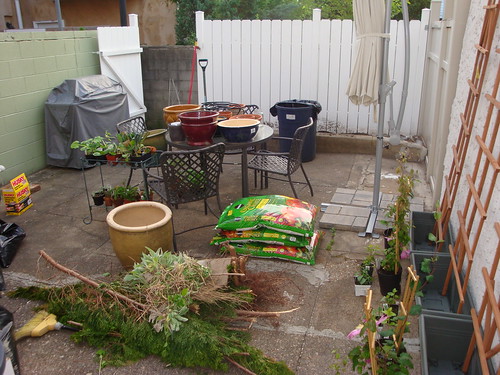 [/caption]
In that dirt's place we put a mixture of organic garden soil and compost that we got (for free) from the city's recycling center near Belmont Plateau (that was an interesting trip... a Subaru with ten plastic-lined cardboard boxes early one weekday morning).
[caption id="" align="alignnone" width="500" caption="Took a lot of dirt and compost to fill this back up. Especially after we uncovered the bodies."]
[/caption]
In that dirt's place we put a mixture of organic garden soil and compost that we got (for free) from the city's recycling center near Belmont Plateau (that was an interesting trip... a Subaru with ten plastic-lined cardboard boxes early one weekday morning).
[caption id="" align="alignnone" width="500" caption="Took a lot of dirt and compost to fill this back up. Especially after we uncovered the bodies."]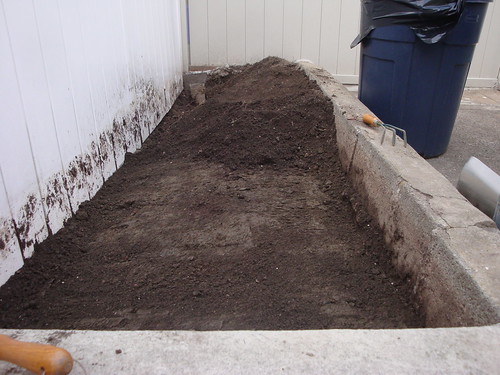 [/caption]
Three by ten may not look big but when you need to fill it with about 24 inches of stuff, well... that's a lot of stuff. Our friend Craig helped us out and soon we had a beautiful, pristine bed of dirt and five, pretty ceramic containers. All that was needed was to plant. We got all of our plants from Greensgrow in Fishtown. Our haul included three different tomato varieties, an eggplant, two zucchini, two yellow squash, kale, Swiss chard, collard greens, a green pepper, a cucumber, basil, mint, sage, parsley and oregano. For decoration we planted a trumpet vine some vinca vine, a couple clematis and a susie mix in troughs that we stuck trellises in and put up against the bright white stucco wall of our neighbor's house. We did our planting in mid-May and sat back to wait for our bounty of tomatoes, cucumbers, herbs and the rest.
Fast forward 3 months to the end of summer 2010 and we had learned a few lessons:
1. Too much water isn't a good thing. Early rain and cool weather teamed up to kill the oregano that we had in a small plant. I pruned back the dead stuff a couple times and it rebounded but finally gave up.
2. Too little water is a terrible thing. In the beginning I was Mr. Enthusiastic. I was out there at 6:30 every morning with the hose, dutifully watering around the base of all my plants and being careful not to get too much water on the leaves where the drops would turn into tiny magnifying glasses that burn holes through them. When the temperatures soared and the rains stopped altogether in mid-July through August, not only did my schedule make it tough for me to get out there every morning but the stuff was completely dry from the afternoon sun - especially in the containers. End result: Container-held kale and Swiss chard didn't die but didn't really produce. Container-held Green peppers that did grow (about 4 of them) were the size of golf balls, we got two or three eggplant before that plant died.
[caption id="" align="alignnone" width="500" caption="That's about as big as these suckers got."]
[/caption]
Three by ten may not look big but when you need to fill it with about 24 inches of stuff, well... that's a lot of stuff. Our friend Craig helped us out and soon we had a beautiful, pristine bed of dirt and five, pretty ceramic containers. All that was needed was to plant. We got all of our plants from Greensgrow in Fishtown. Our haul included three different tomato varieties, an eggplant, two zucchini, two yellow squash, kale, Swiss chard, collard greens, a green pepper, a cucumber, basil, mint, sage, parsley and oregano. For decoration we planted a trumpet vine some vinca vine, a couple clematis and a susie mix in troughs that we stuck trellises in and put up against the bright white stucco wall of our neighbor's house. We did our planting in mid-May and sat back to wait for our bounty of tomatoes, cucumbers, herbs and the rest.
Fast forward 3 months to the end of summer 2010 and we had learned a few lessons:
1. Too much water isn't a good thing. Early rain and cool weather teamed up to kill the oregano that we had in a small plant. I pruned back the dead stuff a couple times and it rebounded but finally gave up.
2. Too little water is a terrible thing. In the beginning I was Mr. Enthusiastic. I was out there at 6:30 every morning with the hose, dutifully watering around the base of all my plants and being careful not to get too much water on the leaves where the drops would turn into tiny magnifying glasses that burn holes through them. When the temperatures soared and the rains stopped altogether in mid-July through August, not only did my schedule make it tough for me to get out there every morning but the stuff was completely dry from the afternoon sun - especially in the containers. End result: Container-held kale and Swiss chard didn't die but didn't really produce. Container-held Green peppers that did grow (about 4 of them) were the size of golf balls, we got two or three eggplant before that plant died.
[caption id="" align="alignnone" width="500" caption="That's about as big as these suckers got."]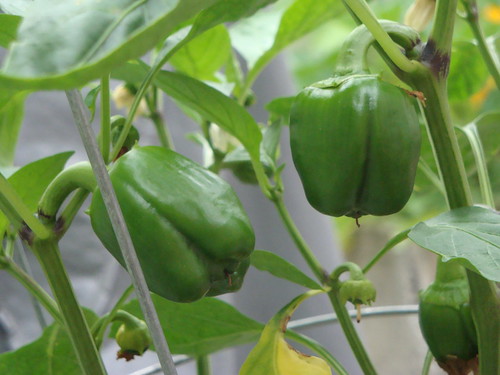 [/caption]
And tomatoes, whose plants grew like crazy in the beginning of summer in our new, rich soil, would stop growing until watered and then grow so fast after being watered that they split their skins.
[caption id="" align="alignnone" width="500" caption="I have seen the end of the world and it is the inside of this tomato."]
[/caption]
And tomatoes, whose plants grew like crazy in the beginning of summer in our new, rich soil, would stop growing until watered and then grow so fast after being watered that they split their skins.
[caption id="" align="alignnone" width="500" caption="I have seen the end of the world and it is the inside of this tomato."]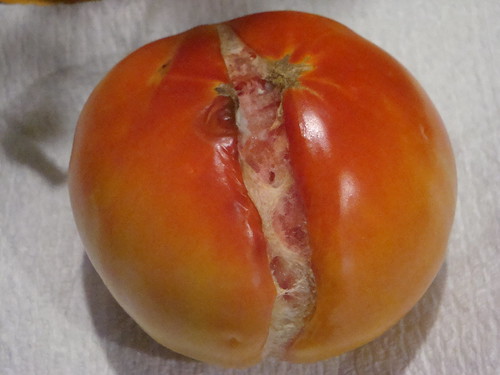 [/caption]
Most of the tomatoes were good for nothing more than frying. The clematis went about three feet up the trellises and died. The trumpet vine did okay but also dried out. Too little water also stresses herbs like basil and mint which causes them to "bolt" or flower since they think their days are numbered and they have to hurry up and reproduce. Once basil bolts it changes the flavor of the leaves so that they are bitter (but they smell great).
3. Bad Bugs suck. There are good bugs - lacewings, lady beetles, bees, butterflies - but we still haven't really figured out how to attract a lot of those (though it's better this year). What we were able to attract last year were big black flies that would land on our cucumber and squash leaves in swarms and just sit there until you shook the plant causing them to rise up like a cloud and buzz around for a while before settling back down. I read somewhere that they were sucking the moisture out of the plant. They were also leaving disgusting droppings on the leaves (and tomatoes). The black flies basically made us not want to be back there. Fly paper caught a few but only made more of a mess and didn't stop the problem.
We also had tiny, tiny white flies that landed on the leafy greens - the kale and chard and collards - and feasted.
[caption id="" align="alignnone" width="500" caption="This picture of the collards was actually taken on October 1 but you can still see the damage - holes - left by the white flies."]
[/caption]
Most of the tomatoes were good for nothing more than frying. The clematis went about three feet up the trellises and died. The trumpet vine did okay but also dried out. Too little water also stresses herbs like basil and mint which causes them to "bolt" or flower since they think their days are numbered and they have to hurry up and reproduce. Once basil bolts it changes the flavor of the leaves so that they are bitter (but they smell great).
3. Bad Bugs suck. There are good bugs - lacewings, lady beetles, bees, butterflies - but we still haven't really figured out how to attract a lot of those (though it's better this year). What we were able to attract last year were big black flies that would land on our cucumber and squash leaves in swarms and just sit there until you shook the plant causing them to rise up like a cloud and buzz around for a while before settling back down. I read somewhere that they were sucking the moisture out of the plant. They were also leaving disgusting droppings on the leaves (and tomatoes). The black flies basically made us not want to be back there. Fly paper caught a few but only made more of a mess and didn't stop the problem.
We also had tiny, tiny white flies that landed on the leafy greens - the kale and chard and collards - and feasted.
[caption id="" align="alignnone" width="500" caption="This picture of the collards was actually taken on October 1 but you can still see the damage - holes - left by the white flies."]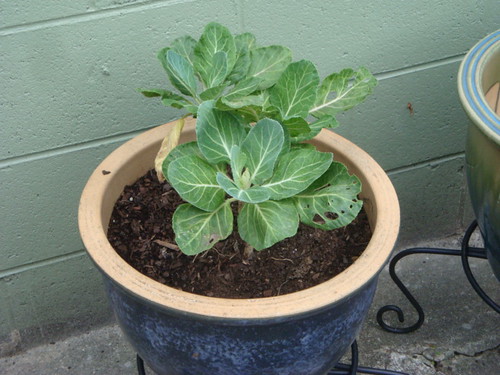 [/caption]
The stress of the dry weather rendered the plants less able to fight off these invaders. At the end of the summer, really gross green worms started appearing on the tomatoes and green caterpillars with yellow spots would appear daily on the parsley (which otherwise was growing pretty well). The green worms had white things on them that I thought were part of them but which I learned were the eggs of a certain parasitic wasp that would eventually hatch and burrow into the worms, eating them from the inside while not being a threat to the plants. Considering what the worms and other bugs were doing to my garden, that process was particularly satisfying. Saw a few slugs but last summer was so hot and dry that even they seemed to retreat to moister, cooler places. Eventually we found out about all-natural, plant-based insecticidal oils and soaps which when diluted in water and misted on leaves every couple weeks would kill the white flies and repel the black ones. By then it was too late. The infestation had taken hold. I basically gave up on the kale and chard. Which leads me to lesson four.
4. Kale and chard are bad asses. I may have given up on them but they didn't give up on themselves. Toward the end of summer I stopped watering them and decided to let them go in peace. To my surprise (again... never gardened before) once the temperatures dropped in the fall and the rains came back, so did the kale and chard.
[caption id="" align="alignnone" width="500" caption="Another October 1 picture. This stuff grew and lasted until the first major snow fall."]
[/caption]
The stress of the dry weather rendered the plants less able to fight off these invaders. At the end of the summer, really gross green worms started appearing on the tomatoes and green caterpillars with yellow spots would appear daily on the parsley (which otherwise was growing pretty well). The green worms had white things on them that I thought were part of them but which I learned were the eggs of a certain parasitic wasp that would eventually hatch and burrow into the worms, eating them from the inside while not being a threat to the plants. Considering what the worms and other bugs were doing to my garden, that process was particularly satisfying. Saw a few slugs but last summer was so hot and dry that even they seemed to retreat to moister, cooler places. Eventually we found out about all-natural, plant-based insecticidal oils and soaps which when diluted in water and misted on leaves every couple weeks would kill the white flies and repel the black ones. By then it was too late. The infestation had taken hold. I basically gave up on the kale and chard. Which leads me to lesson four.
4. Kale and chard are bad asses. I may have given up on them but they didn't give up on themselves. Toward the end of summer I stopped watering them and decided to let them go in peace. To my surprise (again... never gardened before) once the temperatures dropped in the fall and the rains came back, so did the kale and chard.
[caption id="" align="alignnone" width="500" caption="Another October 1 picture. This stuff grew and lasted until the first major snow fall."]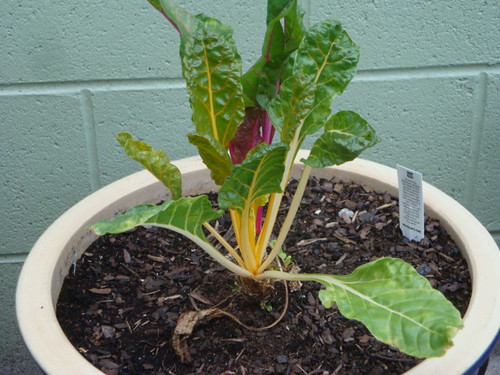 [/caption]
In fact, they kept on going through November and December even as temperatures dropped into the 30s and 40s. The only thing that finally did them in was 20 inches of snow (which nearly did me in too). I had just planted them at the wrong time. Kale and chard like cool weather so should be planted really early in the spring or very late in the summer, especially if you're planting seeds and need two weeks for them to turn into plants. The kale I planted from seed in April this year has already yielded three or four huge bunches that Alison estimated were worth a total of about $60 if purchased at Greensgrow (all for a five-dollar pack of seeds). The chard I planted late but am expecting it to bide its time like last year before taking off in the fall.
5. Squash plants are out of control. On the front row of the bed we planted two zucchini and two yellow squash plants. Behind them were the tomato plants and the cucumber plant. The squash plants quickly spread out with their huge leaves and giant fruit, making it difficult to reach the plants behind them.
[caption id="" align="alignnone" width="500" caption="Taken in mid-June 2010. Cukes and tomatoes along white fence. Zucchini and squash out of control in front of them."]
[/caption]
In fact, they kept on going through November and December even as temperatures dropped into the 30s and 40s. The only thing that finally did them in was 20 inches of snow (which nearly did me in too). I had just planted them at the wrong time. Kale and chard like cool weather so should be planted really early in the spring or very late in the summer, especially if you're planting seeds and need two weeks for them to turn into plants. The kale I planted from seed in April this year has already yielded three or four huge bunches that Alison estimated were worth a total of about $60 if purchased at Greensgrow (all for a five-dollar pack of seeds). The chard I planted late but am expecting it to bide its time like last year before taking off in the fall.
5. Squash plants are out of control. On the front row of the bed we planted two zucchini and two yellow squash plants. Behind them were the tomato plants and the cucumber plant. The squash plants quickly spread out with their huge leaves and giant fruit, making it difficult to reach the plants behind them.
[caption id="" align="alignnone" width="500" caption="Taken in mid-June 2010. Cukes and tomatoes along white fence. Zucchini and squash out of control in front of them."]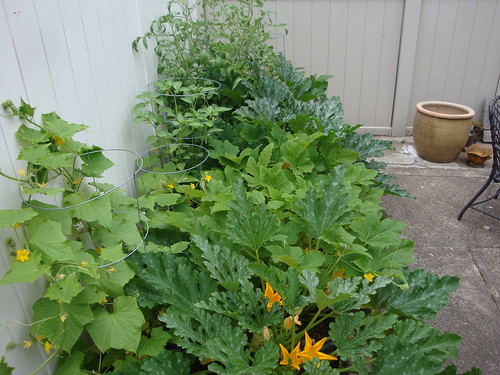 [/caption]
They made a mini jungle that I'm sure was populated by mini monkeys, mini pythons and at least one mini lion (judging from the feline droppings that I occasionally found). The lesson was... fewer squash or zucchini plants.
[caption id="" align="alignnone" width="500" caption="Little tiny kale and chard, one of our three or four eggplants and a some of our many squash and zukes."]
[/caption]
They made a mini jungle that I'm sure was populated by mini monkeys, mini pythons and at least one mini lion (judging from the feline droppings that I occasionally found). The lesson was... fewer squash or zucchini plants.
[caption id="" align="alignnone" width="500" caption="Little tiny kale and chard, one of our three or four eggplants and a some of our many squash and zukes."]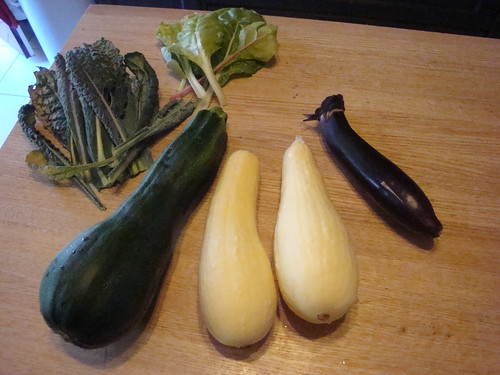 [/caption]
The ones we had yielded a ton of fruit, some as large as bowling pins.
[caption id="" align="alignnone" width="500" caption="I think this guy made all the other zucchini feel a little inadequate."]
[/caption]
The ones we had yielded a ton of fruit, some as large as bowling pins.
[caption id="" align="alignnone" width="500" caption="I think this guy made all the other zucchini feel a little inadequate."]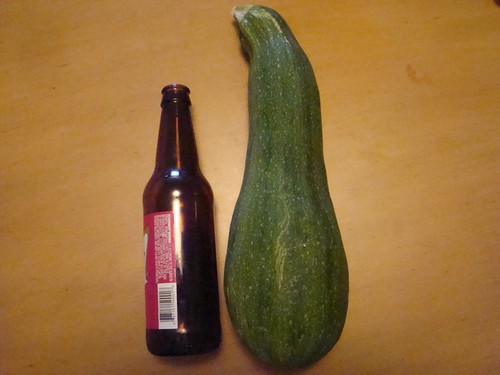 [/caption]
(Other lesson... don't let them grow that large on the plant. They turn woody.) So the yield was great but at the expense of being able to tend to the rest of the bed. I'm probably making a different mistake with the zucchini this year but I'll talk about that in a later post.
6. Don't let those herbs bolt. See above. You can trick the basil into not turning bitter by clipping off the first signs of flowers. Once the plant starts directing its photosynthetic energy towards the flowers, the flavor of the leaves suffers. Snip those flowers right off.
[caption id="" align="alignnone" width="500" caption="Pretty much all the tomatoes we got last year and you can see the little black specks left behind by those gross black flies."]
[/caption]
(Other lesson... don't let them grow that large on the plant. They turn woody.) So the yield was great but at the expense of being able to tend to the rest of the bed. I'm probably making a different mistake with the zucchini this year but I'll talk about that in a later post.
6. Don't let those herbs bolt. See above. You can trick the basil into not turning bitter by clipping off the first signs of flowers. Once the plant starts directing its photosynthetic energy towards the flowers, the flavor of the leaves suffers. Snip those flowers right off.
[caption id="" align="alignnone" width="500" caption="Pretty much all the tomatoes we got last year and you can see the little black specks left behind by those gross black flies."]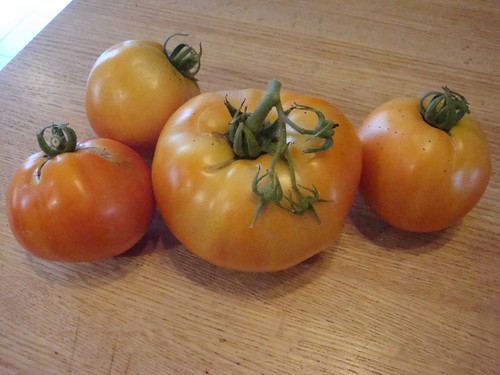 [/caption]
7. Apparently, letting your tomato plants grow like wild isn't good either. At first we were thrilled with out fast and tall and bushy the tomato plants got. You can see them in the photo of the whole bed above. Surely these would yield dozens and dozens of sweet, juicy, delicious fruit. Well, you already read what happens when you water sporadically. We also learned that if you let the plants grow and grow, they feel secure that they will live long happy lives and not feel pressure to make new plants. In other words - less fruit. A least a few different people told us that you should prune the tomato plants and not let them get more than three or four feet high. I'm still not sold on it. I suspect our lack of pollinating insects had something to do with the low yield. But I'm trying it this year anyway. More to follow on how that works. So 2010 tomato plants - nice big plants, very few crappy split-skin tomatoes.
By summer's end I had grown so frustrated that I couldn't wait to uproot many of the plants and send them off to the compost heap. All I wanted was to look out on the pristine 3x10 bed whose rich, black soil would hold the promise of future harvests rather than the stench of a failed season.
[caption id="" align="alignnone" width="500" caption="October 1, 2010 and the chaos has been removed in preparation for winter. Couple tomato plants left to stand guard."]
[/caption]
7. Apparently, letting your tomato plants grow like wild isn't good either. At first we were thrilled with out fast and tall and bushy the tomato plants got. You can see them in the photo of the whole bed above. Surely these would yield dozens and dozens of sweet, juicy, delicious fruit. Well, you already read what happens when you water sporadically. We also learned that if you let the plants grow and grow, they feel secure that they will live long happy lives and not feel pressure to make new plants. In other words - less fruit. A least a few different people told us that you should prune the tomato plants and not let them get more than three or four feet high. I'm still not sold on it. I suspect our lack of pollinating insects had something to do with the low yield. But I'm trying it this year anyway. More to follow on how that works. So 2010 tomato plants - nice big plants, very few crappy split-skin tomatoes.
By summer's end I had grown so frustrated that I couldn't wait to uproot many of the plants and send them off to the compost heap. All I wanted was to look out on the pristine 3x10 bed whose rich, black soil would hold the promise of future harvests rather than the stench of a failed season.
[caption id="" align="alignnone" width="500" caption="October 1, 2010 and the chaos has been removed in preparation for winter. Couple tomato plants left to stand guard."]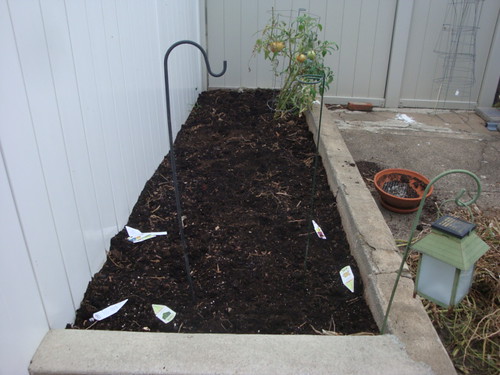 [/caption]
I left a few tomato plants in place to die and Alison pulled out the now spent zucchini, eggplant, squash and cucumber plants.
[caption id="" align="alignnone" width="500" caption="Vegetable garden armageddon on October 1. Empty pot used to hold the mint."]
[/caption]
I left a few tomato plants in place to die and Alison pulled out the now spent zucchini, eggplant, squash and cucumber plants.
[caption id="" align="alignnone" width="500" caption="Vegetable garden armageddon on October 1. Empty pot used to hold the mint."]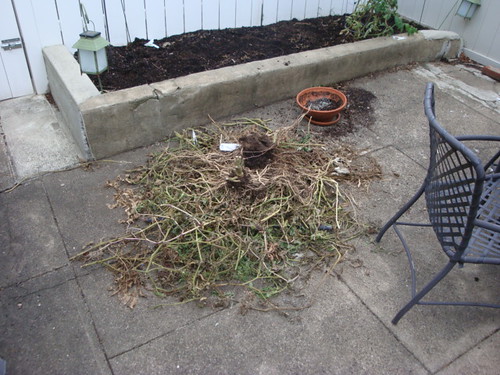 [/caption]
We emptied the small pots that held many of the herbs and the larger pot that contained the mint (which put up a good fight for most of the summer but finally could live with my watering schedule). As I said, I left the chard and kale, mostly because I couldn't be bothered to lift the heavy ceramic containers they lived in. And the clematis seemed so pathetic that I just cut the dead brown strands away from the trellis and didn't bother with the rest of it.
The approach of fall and winter gave me time to step back from the whole experience and think about what I needed to do differently for 2011. In my next post - far shorter, I promise - I'll share what I did in during the winter months. Baseball general managers make trades and sign free agents to make their teams stronger. Gardeners (which I don't consider myself to be yet) also have their off-season acquisitions.
Sarah will be back next week, hopefully with her plants still in tact.
P.S. After growing and dying and growing and dying and then completely disappearing, guess what came back by October of last year:
[caption id="" align="alignnone" width="500" caption="Welcome back, oregano!"]
[/caption]
We emptied the small pots that held many of the herbs and the larger pot that contained the mint (which put up a good fight for most of the summer but finally could live with my watering schedule). As I said, I left the chard and kale, mostly because I couldn't be bothered to lift the heavy ceramic containers they lived in. And the clematis seemed so pathetic that I just cut the dead brown strands away from the trellis and didn't bother with the rest of it.
The approach of fall and winter gave me time to step back from the whole experience and think about what I needed to do differently for 2011. In my next post - far shorter, I promise - I'll share what I did in during the winter months. Baseball general managers make trades and sign free agents to make their teams stronger. Gardeners (which I don't consider myself to be yet) also have their off-season acquisitions.
Sarah will be back next week, hopefully with her plants still in tact.
P.S. After growing and dying and growing and dying and then completely disappearing, guess what came back by October of last year:
[caption id="" align="alignnone" width="500" caption="Welcome back, oregano!"]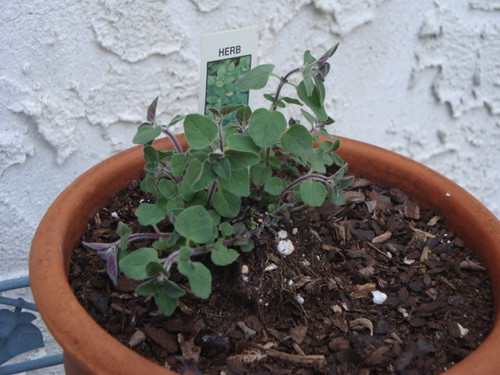 [/caption]
Pretty tough stuff.
[/caption]
Pretty tough stuff.
 [/caption]
In that dirt's place we put a mixture of organic garden soil and compost that we got (for free) from the city's recycling center near Belmont Plateau (that was an interesting trip... a Subaru with ten plastic-lined cardboard boxes early one weekday morning).
[caption id="" align="alignnone" width="500" caption="Took a lot of dirt and compost to fill this back up. Especially after we uncovered the bodies."]
[/caption]
In that dirt's place we put a mixture of organic garden soil and compost that we got (for free) from the city's recycling center near Belmont Plateau (that was an interesting trip... a Subaru with ten plastic-lined cardboard boxes early one weekday morning).
[caption id="" align="alignnone" width="500" caption="Took a lot of dirt and compost to fill this back up. Especially after we uncovered the bodies."] [/caption]
Three by ten may not look big but when you need to fill it with about 24 inches of stuff, well... that's a lot of stuff. Our friend Craig helped us out and soon we had a beautiful, pristine bed of dirt and five, pretty ceramic containers. All that was needed was to plant. We got all of our plants from Greensgrow in Fishtown. Our haul included three different tomato varieties, an eggplant, two zucchini, two yellow squash, kale, Swiss chard, collard greens, a green pepper, a cucumber, basil, mint, sage, parsley and oregano. For decoration we planted a trumpet vine some vinca vine, a couple clematis and a susie mix in troughs that we stuck trellises in and put up against the bright white stucco wall of our neighbor's house. We did our planting in mid-May and sat back to wait for our bounty of tomatoes, cucumbers, herbs and the rest.
Fast forward 3 months to the end of summer 2010 and we had learned a few lessons:
1. Too much water isn't a good thing. Early rain and cool weather teamed up to kill the oregano that we had in a small plant. I pruned back the dead stuff a couple times and it rebounded but finally gave up.
2. Too little water is a terrible thing. In the beginning I was Mr. Enthusiastic. I was out there at 6:30 every morning with the hose, dutifully watering around the base of all my plants and being careful not to get too much water on the leaves where the drops would turn into tiny magnifying glasses that burn holes through them. When the temperatures soared and the rains stopped altogether in mid-July through August, not only did my schedule make it tough for me to get out there every morning but the stuff was completely dry from the afternoon sun - especially in the containers. End result: Container-held kale and Swiss chard didn't die but didn't really produce. Container-held Green peppers that did grow (about 4 of them) were the size of golf balls, we got two or three eggplant before that plant died.
[caption id="" align="alignnone" width="500" caption="That's about as big as these suckers got."]
[/caption]
Three by ten may not look big but when you need to fill it with about 24 inches of stuff, well... that's a lot of stuff. Our friend Craig helped us out and soon we had a beautiful, pristine bed of dirt and five, pretty ceramic containers. All that was needed was to plant. We got all of our plants from Greensgrow in Fishtown. Our haul included three different tomato varieties, an eggplant, two zucchini, two yellow squash, kale, Swiss chard, collard greens, a green pepper, a cucumber, basil, mint, sage, parsley and oregano. For decoration we planted a trumpet vine some vinca vine, a couple clematis and a susie mix in troughs that we stuck trellises in and put up against the bright white stucco wall of our neighbor's house. We did our planting in mid-May and sat back to wait for our bounty of tomatoes, cucumbers, herbs and the rest.
Fast forward 3 months to the end of summer 2010 and we had learned a few lessons:
1. Too much water isn't a good thing. Early rain and cool weather teamed up to kill the oregano that we had in a small plant. I pruned back the dead stuff a couple times and it rebounded but finally gave up.
2. Too little water is a terrible thing. In the beginning I was Mr. Enthusiastic. I was out there at 6:30 every morning with the hose, dutifully watering around the base of all my plants and being careful not to get too much water on the leaves where the drops would turn into tiny magnifying glasses that burn holes through them. When the temperatures soared and the rains stopped altogether in mid-July through August, not only did my schedule make it tough for me to get out there every morning but the stuff was completely dry from the afternoon sun - especially in the containers. End result: Container-held kale and Swiss chard didn't die but didn't really produce. Container-held Green peppers that did grow (about 4 of them) were the size of golf balls, we got two or three eggplant before that plant died.
[caption id="" align="alignnone" width="500" caption="That's about as big as these suckers got."] [/caption]
And tomatoes, whose plants grew like crazy in the beginning of summer in our new, rich soil, would stop growing until watered and then grow so fast after being watered that they split their skins.
[caption id="" align="alignnone" width="500" caption="I have seen the end of the world and it is the inside of this tomato."]
[/caption]
And tomatoes, whose plants grew like crazy in the beginning of summer in our new, rich soil, would stop growing until watered and then grow so fast after being watered that they split their skins.
[caption id="" align="alignnone" width="500" caption="I have seen the end of the world and it is the inside of this tomato."] [/caption]
Most of the tomatoes were good for nothing more than frying. The clematis went about three feet up the trellises and died. The trumpet vine did okay but also dried out. Too little water also stresses herbs like basil and mint which causes them to "bolt" or flower since they think their days are numbered and they have to hurry up and reproduce. Once basil bolts it changes the flavor of the leaves so that they are bitter (but they smell great).
3. Bad Bugs suck. There are good bugs - lacewings, lady beetles, bees, butterflies - but we still haven't really figured out how to attract a lot of those (though it's better this year). What we were able to attract last year were big black flies that would land on our cucumber and squash leaves in swarms and just sit there until you shook the plant causing them to rise up like a cloud and buzz around for a while before settling back down. I read somewhere that they were sucking the moisture out of the plant. They were also leaving disgusting droppings on the leaves (and tomatoes). The black flies basically made us not want to be back there. Fly paper caught a few but only made more of a mess and didn't stop the problem.
We also had tiny, tiny white flies that landed on the leafy greens - the kale and chard and collards - and feasted.
[caption id="" align="alignnone" width="500" caption="This picture of the collards was actually taken on October 1 but you can still see the damage - holes - left by the white flies."]
[/caption]
Most of the tomatoes were good for nothing more than frying. The clematis went about three feet up the trellises and died. The trumpet vine did okay but also dried out. Too little water also stresses herbs like basil and mint which causes them to "bolt" or flower since they think their days are numbered and they have to hurry up and reproduce. Once basil bolts it changes the flavor of the leaves so that they are bitter (but they smell great).
3. Bad Bugs suck. There are good bugs - lacewings, lady beetles, bees, butterflies - but we still haven't really figured out how to attract a lot of those (though it's better this year). What we were able to attract last year were big black flies that would land on our cucumber and squash leaves in swarms and just sit there until you shook the plant causing them to rise up like a cloud and buzz around for a while before settling back down. I read somewhere that they were sucking the moisture out of the plant. They were also leaving disgusting droppings on the leaves (and tomatoes). The black flies basically made us not want to be back there. Fly paper caught a few but only made more of a mess and didn't stop the problem.
We also had tiny, tiny white flies that landed on the leafy greens - the kale and chard and collards - and feasted.
[caption id="" align="alignnone" width="500" caption="This picture of the collards was actually taken on October 1 but you can still see the damage - holes - left by the white flies."] [/caption]
The stress of the dry weather rendered the plants less able to fight off these invaders. At the end of the summer, really gross green worms started appearing on the tomatoes and green caterpillars with yellow spots would appear daily on the parsley (which otherwise was growing pretty well). The green worms had white things on them that I thought were part of them but which I learned were the eggs of a certain parasitic wasp that would eventually hatch and burrow into the worms, eating them from the inside while not being a threat to the plants. Considering what the worms and other bugs were doing to my garden, that process was particularly satisfying. Saw a few slugs but last summer was so hot and dry that even they seemed to retreat to moister, cooler places. Eventually we found out about all-natural, plant-based insecticidal oils and soaps which when diluted in water and misted on leaves every couple weeks would kill the white flies and repel the black ones. By then it was too late. The infestation had taken hold. I basically gave up on the kale and chard. Which leads me to lesson four.
4. Kale and chard are bad asses. I may have given up on them but they didn't give up on themselves. Toward the end of summer I stopped watering them and decided to let them go in peace. To my surprise (again... never gardened before) once the temperatures dropped in the fall and the rains came back, so did the kale and chard.
[caption id="" align="alignnone" width="500" caption="Another October 1 picture. This stuff grew and lasted until the first major snow fall."]
[/caption]
The stress of the dry weather rendered the plants less able to fight off these invaders. At the end of the summer, really gross green worms started appearing on the tomatoes and green caterpillars with yellow spots would appear daily on the parsley (which otherwise was growing pretty well). The green worms had white things on them that I thought were part of them but which I learned were the eggs of a certain parasitic wasp that would eventually hatch and burrow into the worms, eating them from the inside while not being a threat to the plants. Considering what the worms and other bugs were doing to my garden, that process was particularly satisfying. Saw a few slugs but last summer was so hot and dry that even they seemed to retreat to moister, cooler places. Eventually we found out about all-natural, plant-based insecticidal oils and soaps which when diluted in water and misted on leaves every couple weeks would kill the white flies and repel the black ones. By then it was too late. The infestation had taken hold. I basically gave up on the kale and chard. Which leads me to lesson four.
4. Kale and chard are bad asses. I may have given up on them but they didn't give up on themselves. Toward the end of summer I stopped watering them and decided to let them go in peace. To my surprise (again... never gardened before) once the temperatures dropped in the fall and the rains came back, so did the kale and chard.
[caption id="" align="alignnone" width="500" caption="Another October 1 picture. This stuff grew and lasted until the first major snow fall."] [/caption]
In fact, they kept on going through November and December even as temperatures dropped into the 30s and 40s. The only thing that finally did them in was 20 inches of snow (which nearly did me in too). I had just planted them at the wrong time. Kale and chard like cool weather so should be planted really early in the spring or very late in the summer, especially if you're planting seeds and need two weeks for them to turn into plants. The kale I planted from seed in April this year has already yielded three or four huge bunches that Alison estimated were worth a total of about $60 if purchased at Greensgrow (all for a five-dollar pack of seeds). The chard I planted late but am expecting it to bide its time like last year before taking off in the fall.
5. Squash plants are out of control. On the front row of the bed we planted two zucchini and two yellow squash plants. Behind them were the tomato plants and the cucumber plant. The squash plants quickly spread out with their huge leaves and giant fruit, making it difficult to reach the plants behind them.
[caption id="" align="alignnone" width="500" caption="Taken in mid-June 2010. Cukes and tomatoes along white fence. Zucchini and squash out of control in front of them."]
[/caption]
In fact, they kept on going through November and December even as temperatures dropped into the 30s and 40s. The only thing that finally did them in was 20 inches of snow (which nearly did me in too). I had just planted them at the wrong time. Kale and chard like cool weather so should be planted really early in the spring or very late in the summer, especially if you're planting seeds and need two weeks for them to turn into plants. The kale I planted from seed in April this year has already yielded three or four huge bunches that Alison estimated were worth a total of about $60 if purchased at Greensgrow (all for a five-dollar pack of seeds). The chard I planted late but am expecting it to bide its time like last year before taking off in the fall.
5. Squash plants are out of control. On the front row of the bed we planted two zucchini and two yellow squash plants. Behind them were the tomato plants and the cucumber plant. The squash plants quickly spread out with their huge leaves and giant fruit, making it difficult to reach the plants behind them.
[caption id="" align="alignnone" width="500" caption="Taken in mid-June 2010. Cukes and tomatoes along white fence. Zucchini and squash out of control in front of them."] [/caption]
They made a mini jungle that I'm sure was populated by mini monkeys, mini pythons and at least one mini lion (judging from the feline droppings that I occasionally found). The lesson was... fewer squash or zucchini plants.
[caption id="" align="alignnone" width="500" caption="Little tiny kale and chard, one of our three or four eggplants and a some of our many squash and zukes."]
[/caption]
They made a mini jungle that I'm sure was populated by mini monkeys, mini pythons and at least one mini lion (judging from the feline droppings that I occasionally found). The lesson was... fewer squash or zucchini plants.
[caption id="" align="alignnone" width="500" caption="Little tiny kale and chard, one of our three or four eggplants and a some of our many squash and zukes."] [/caption]
The ones we had yielded a ton of fruit, some as large as bowling pins.
[caption id="" align="alignnone" width="500" caption="I think this guy made all the other zucchini feel a little inadequate."]
[/caption]
The ones we had yielded a ton of fruit, some as large as bowling pins.
[caption id="" align="alignnone" width="500" caption="I think this guy made all the other zucchini feel a little inadequate."] [/caption]
(Other lesson... don't let them grow that large on the plant. They turn woody.) So the yield was great but at the expense of being able to tend to the rest of the bed. I'm probably making a different mistake with the zucchini this year but I'll talk about that in a later post.
6. Don't let those herbs bolt. See above. You can trick the basil into not turning bitter by clipping off the first signs of flowers. Once the plant starts directing its photosynthetic energy towards the flowers, the flavor of the leaves suffers. Snip those flowers right off.
[caption id="" align="alignnone" width="500" caption="Pretty much all the tomatoes we got last year and you can see the little black specks left behind by those gross black flies."]
[/caption]
(Other lesson... don't let them grow that large on the plant. They turn woody.) So the yield was great but at the expense of being able to tend to the rest of the bed. I'm probably making a different mistake with the zucchini this year but I'll talk about that in a later post.
6. Don't let those herbs bolt. See above. You can trick the basil into not turning bitter by clipping off the first signs of flowers. Once the plant starts directing its photosynthetic energy towards the flowers, the flavor of the leaves suffers. Snip those flowers right off.
[caption id="" align="alignnone" width="500" caption="Pretty much all the tomatoes we got last year and you can see the little black specks left behind by those gross black flies."] [/caption]
7. Apparently, letting your tomato plants grow like wild isn't good either. At first we were thrilled with out fast and tall and bushy the tomato plants got. You can see them in the photo of the whole bed above. Surely these would yield dozens and dozens of sweet, juicy, delicious fruit. Well, you already read what happens when you water sporadically. We also learned that if you let the plants grow and grow, they feel secure that they will live long happy lives and not feel pressure to make new plants. In other words - less fruit. A least a few different people told us that you should prune the tomato plants and not let them get more than three or four feet high. I'm still not sold on it. I suspect our lack of pollinating insects had something to do with the low yield. But I'm trying it this year anyway. More to follow on how that works. So 2010 tomato plants - nice big plants, very few crappy split-skin tomatoes.
By summer's end I had grown so frustrated that I couldn't wait to uproot many of the plants and send them off to the compost heap. All I wanted was to look out on the pristine 3x10 bed whose rich, black soil would hold the promise of future harvests rather than the stench of a failed season.
[caption id="" align="alignnone" width="500" caption="October 1, 2010 and the chaos has been removed in preparation for winter. Couple tomato plants left to stand guard."]
[/caption]
7. Apparently, letting your tomato plants grow like wild isn't good either. At first we were thrilled with out fast and tall and bushy the tomato plants got. You can see them in the photo of the whole bed above. Surely these would yield dozens and dozens of sweet, juicy, delicious fruit. Well, you already read what happens when you water sporadically. We also learned that if you let the plants grow and grow, they feel secure that they will live long happy lives and not feel pressure to make new plants. In other words - less fruit. A least a few different people told us that you should prune the tomato plants and not let them get more than three or four feet high. I'm still not sold on it. I suspect our lack of pollinating insects had something to do with the low yield. But I'm trying it this year anyway. More to follow on how that works. So 2010 tomato plants - nice big plants, very few crappy split-skin tomatoes.
By summer's end I had grown so frustrated that I couldn't wait to uproot many of the plants and send them off to the compost heap. All I wanted was to look out on the pristine 3x10 bed whose rich, black soil would hold the promise of future harvests rather than the stench of a failed season.
[caption id="" align="alignnone" width="500" caption="October 1, 2010 and the chaos has been removed in preparation for winter. Couple tomato plants left to stand guard."] [/caption]
I left a few tomato plants in place to die and Alison pulled out the now spent zucchini, eggplant, squash and cucumber plants.
[caption id="" align="alignnone" width="500" caption="Vegetable garden armageddon on October 1. Empty pot used to hold the mint."]
[/caption]
I left a few tomato plants in place to die and Alison pulled out the now spent zucchini, eggplant, squash and cucumber plants.
[caption id="" align="alignnone" width="500" caption="Vegetable garden armageddon on October 1. Empty pot used to hold the mint."] [/caption]
We emptied the small pots that held many of the herbs and the larger pot that contained the mint (which put up a good fight for most of the summer but finally could live with my watering schedule). As I said, I left the chard and kale, mostly because I couldn't be bothered to lift the heavy ceramic containers they lived in. And the clematis seemed so pathetic that I just cut the dead brown strands away from the trellis and didn't bother with the rest of it.
The approach of fall and winter gave me time to step back from the whole experience and think about what I needed to do differently for 2011. In my next post - far shorter, I promise - I'll share what I did in during the winter months. Baseball general managers make trades and sign free agents to make their teams stronger. Gardeners (which I don't consider myself to be yet) also have their off-season acquisitions.
Sarah will be back next week, hopefully with her plants still in tact.
P.S. After growing and dying and growing and dying and then completely disappearing, guess what came back by October of last year:
[caption id="" align="alignnone" width="500" caption="Welcome back, oregano!"]
[/caption]
We emptied the small pots that held many of the herbs and the larger pot that contained the mint (which put up a good fight for most of the summer but finally could live with my watering schedule). As I said, I left the chard and kale, mostly because I couldn't be bothered to lift the heavy ceramic containers they lived in. And the clematis seemed so pathetic that I just cut the dead brown strands away from the trellis and didn't bother with the rest of it.
The approach of fall and winter gave me time to step back from the whole experience and think about what I needed to do differently for 2011. In my next post - far shorter, I promise - I'll share what I did in during the winter months. Baseball general managers make trades and sign free agents to make their teams stronger. Gardeners (which I don't consider myself to be yet) also have their off-season acquisitions.
Sarah will be back next week, hopefully with her plants still in tact.
P.S. After growing and dying and growing and dying and then completely disappearing, guess what came back by October of last year:
[caption id="" align="alignnone" width="500" caption="Welcome back, oregano!"] [/caption]
Pretty tough stuff.
[/caption]
Pretty tough stuff.
